Introduction
The Greek word for military equipment roughly translates to hopla, and thus a hoplite simply meant ‘man at arms’ or ‘armored man’. Of course, unlike the man-at-arms of the late medieval period, the hoplite was first and foremost a citizen-soldier. So the hoplite soldier was expected to take part in battles to safeguard his own interests and holdings, as opposed to viewing the military as a well-paying career.
And while the ‘classic’ well-armored and trained Greek soldier was ultimately eclipsed by the more tactical Macedonian phalanx in the late 4th century BC, Greek hoplites (and their predecessors) had dominated the European battlefields for almost three centuries before that. So without further ado, let us check out some incredible historical insights you should know about the ancient Classical Greek hoplites (circa 5th – 4th century BC).
Fun Fact – The word ‘hoplite’ has been often ascribed as being derived from ‘hoplon’, the shield carried by these soldiers. However, modern studies have concluded that the shield was indeed called aspis (not hoplon) by ancient Greeks. As such, the term ‘hoplon’ was possibly mistakenly (or anachronistically) used by Diodorus Siculus, in the 1st century BC.
Contents
- Introduction
- ‘Tribes’ without Blood Relations
- The Oath of the ‘Youths’
- Hoplitodromos – the Hoplite Race of Ancient Greece
- ‘Buddies’ and ‘Lovers’
- The Hoplite Equipment – Armor and Weapons
- Classical Greek Hoplites Probably Favored Mobility
- The Hoplite Phalanx
- Overarm Thrusts or Upward Thrusts?
- The Famed Helmet Crests were just for Show and Pomp
- Physical Infirmity was Possibly Overlooked in Case of Spartan Hoplites
- Wine Before Battle
- Conclusion – Morale More Important Than Numbers
‘Tribes’ without Blood Relations
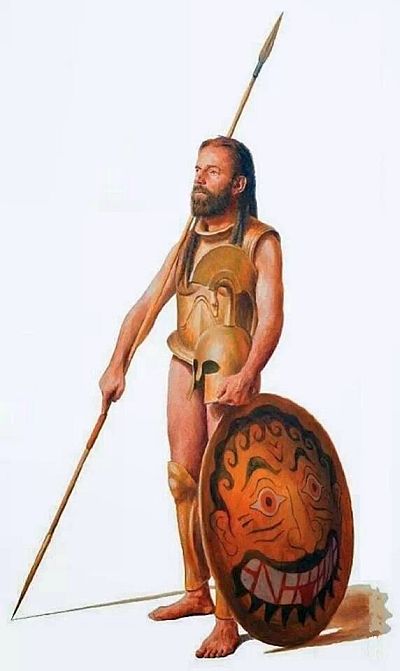
The so-called ‘tribe’ in Greek city-states was rather a politico-military evolution, contrary to what ‘tribal’ warfare suggests. Simply put, the state probably organized its citizens and thus able-bodied men into tribes that had a purpose both census-wise and politically – as opposed to the conventional tribe that is primarily tied by blood relations. This arrangement possibly took root in the 7th century BC as a more immediate solution for organized warfare and defense.
In short, the tribe system (with ties of the citizenry, not blood) was a natural evolution of the Greek society and military that required disciplined formations and trained men for protracted warfare, a factor that was rarely encountered (beyond literature) in the previous ‘heroic ages’.
Such measures over time gave rise to the Greek hoplites, a class of warriors who were not really separate from the citizens themselves. In essence, a hoplite was a citizen-soldier who took up arms to defend or expand the realm of his city-state. And it should be noted that as a general rule, most adult males of the Greek city-states were expected to perform military service.
The Oath of the ‘Youths’
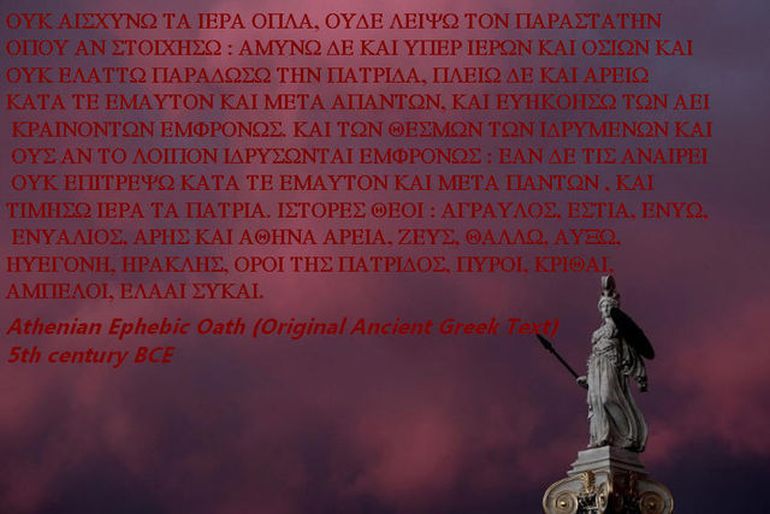
The road to maturity for males of most Greek city-states started with military training after the passing of his 18th year (Spartans had a different military system, as discussed here). These adults gathered at one place after their birth records and census were cross-checked – an occasion that took place at the start of every year, which in most ancient Greek calendars was just after the passing of summer.
And on clearing these official requirements, they were asked to dress in the full war panoply and then utter an oath. In the case of Athens, the oath was taken in the Temple of Aglauros, and the (preserved) text is as follows –
I will not disgrace my sacred arms nor desert my comrade, wherever I am stationed. I will fight for things sacred and things profane. And both alone and with all to help me. I will transmit my fatherland not diminished but greater and better than before. I will obey the ruling magistrates who rule reasonably, and I will observe the established laws and whatever laws in the future may be reasonably established.
If any person seeks to overturn the laws, both alone and with all to help me, I will oppose him. I will honor the religion of my fathers. I call to witness the Gods Agraulus, Hestia, Enyo, Enyalius, Ares, Athena the Warrior, Zeus, Thallo, Auxo, Hegemone, Heracles, and the boundaries of my native land, the wheat, the barley, the vines, and the trees of the olive and the fig.
It is better known as the Ephebic Oath and the young men themselves were called the epheboi (youths) after the ceremony. This marked the starting phase of the next two years of introductory military training known as ephebate – mostly comprising a slew of athletic contests. As for the oath in question, it was found in a preserved state on an engraved 4th-century BC stele, inside the ancient Athenian deme (township) of Archarnae.
Hoplitodromos – the Hoplite Race of Ancient Greece
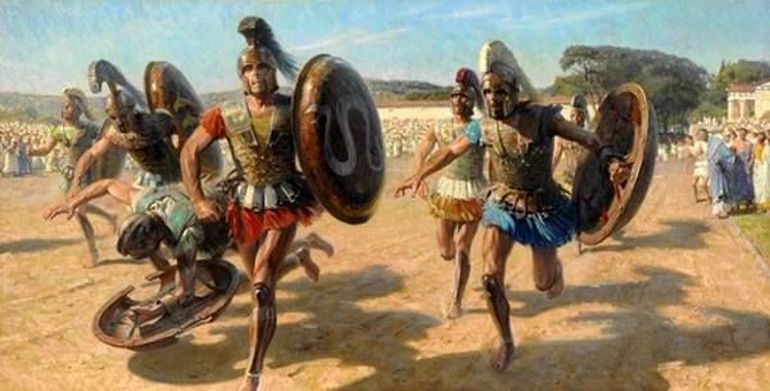
As we discussed in the previous entry, the ephebate training started with the practice of different athletic endeavors. One of these state-organized activities entailed the hoplitodromos – an ancient foot race probably making its debut at Olympia in 520 BC.
Interestingly, the race event may have been introduced when the first Greek armies encountered the Persians who were known for their fast archery skills. So a conjecture (although not proven) can be drawn on how the race was possibly developed and initiated as a fast-moving maneuver for training the Greek hoplites to “catch up” to the Persian archers.
To that end, the young hoplites were required to run over a distance of 350-400 m (around 1,300 ft) that covered a single lap of the stadium (or two stades). But at times, the sprinting track was expanded. For example, at Nemea, the distance was increased to 700-800 m, while at Plataea the distance was kept at a whopping 15 stades.
This running passage (possibly) emulated the battlefield tactic of rushing through the enemy skirmishers to reach their actual lines – with 400 m being the standard arc on which the Persian archers were most effective.
Now while the distance in itself was substantial, it also should also be taken into account that the participants had to run in their partial Greek hoplite panoply, including the weighty helmets and greaves. Moreover, they also had to carry shields – which were probably ‘testing’ imitations specifically crafted for the hoplitodromos events.
In other words, the shields used in the race might have been lighter counterparts to the actual aspis, the heavier wooden shield (reinforced with a thin sheet of bronze) originally carried in battles.
‘Buddies’ and ‘Lovers’
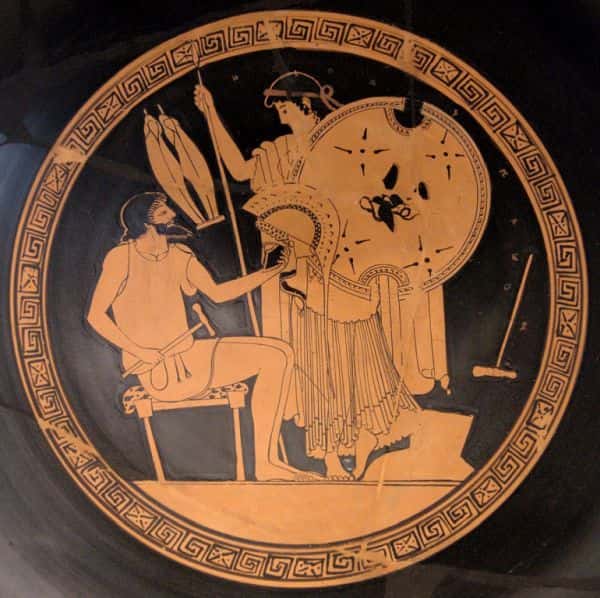
In buddy cop movies, the trope usually involves the pairing of a young, ‘green’ but dynamic candidate with an older, wiser, and grizzled police veteran. And it seems even the ancient Greek hoplites were quite fond of a similar social set-up where the epheboi (youth) was paired with an older man who still trained in gymnasia.
Now in a conventional scenario, the older male was expected to act as the younger trainee’s guardian and thus was responsible for the youth’s conduct, courage, and even military training during the ephebate period.
However, Greek sources frequently denote such pairs as ‘lovers’ – which is not meant to be taken literally in a sexual sense. In fact, Xenophon made it clear how purely physical relationships between males could be officially banned from the state, especially in accordance with the social norms of Classical Athens.
But that didn’t necessarily stop a few pairs from carrying on their illicit relationships, with some cases possibly even perceived as rites of initiation to the military (as opposed to love affairs). Interestingly enough, comedies of that age tended to exaggerate such scenarios inside the gymnasia for sensational effect. Xenophon also attests to the love between young men being prevalent in places like Thebes and Elis.
The Hoplite Equipment – Armor and Weapons
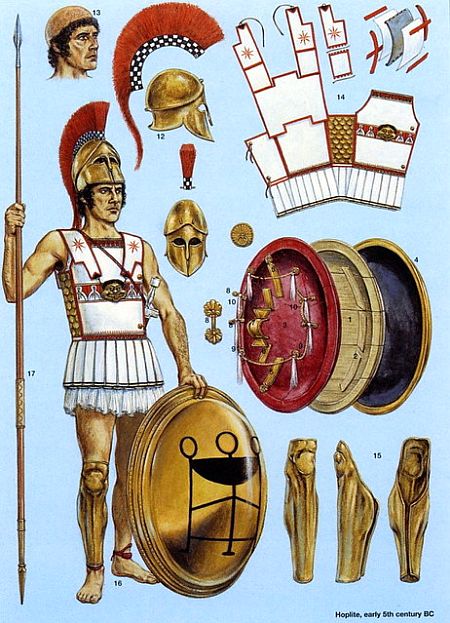
From social matters, we move to the military side of affairs. And to that end, the hoplite could certainly be considered a heavily armed foot soldier of the ancient world – although his armor certainly varied over the centuries. However, many hoplites of the 5th century (Classical Period) had some form of uniformity when it came to their war panoply.
To start things off, we must understand that the typical hoplite equipment was expensive, so much so that many of the panoplies were passed down from father to son. Of course, the poorer citizens had to make do with only a shield and spear, but no armor and in some cases even no helmets. And it was only by the 4th century BC that city-states began to issue ‘factory-made’ (or standardized) hoplite equipment to their armed forces.
In that regard, the most important part of the hoplite’s equipment was the large round aspis shield carried by the left arm. Usually weighing around 13.5 pounds, this hoplite’s shield was probably made from sturdy laminated layers of hardy wood and then embossed with a thin layer of bronze. The outer surface of the aspis was decorated or painted with various motifs and blazons – with some even signifying the status of the richer upper-class hoplites.
For protection, the typical middle-class hoplite also wore a bronze helmet. Now once again, reverting to popular culture, the Greek art depictions are often that of the ornate Corinthian helmet. However, when it came to practicality, especially during intense battle scenarios, the Corinthian helmets may have proved to be somewhat obtrusive to many of its wearers.
One of the reasons might have been the closed nature of the design that impeded the peripheral vision of the wearer, along with possible obstruction to their hearing capacity. To that end, the typical Spartan hoplite, ever ‘spartan’ in his means, preferred the simple conical Pilos helmet. The Classical Athenian hoplites, on the other hand, may have adopted more variance in style, ranging from Chalcidian to Attic helmets.
As for body armor, there were mainly two types – the heavier muscled cuirass made of bronze breast and back plates; and the lighter composite cuirass (also called linothorax) made from layers of hardened linen or leather, sometimes reinforced with iron or bronze points and scales. The armor also extended below to account for pteruges (wings), which were basically reinforced leather flaps to protect the groin area. Additional greaves were worn to protect the shins.
And coming to offensive arms, the main weapon of the hoplite pertains to the 8 to 9-foot-long spear. Known as dory (or doru), these spears were generally made of ash wood, probably due to their longer grains that allowed for larger pieces – thereby having the advantages of both lightness and strength.
The spearhead, with its curved leaf shape, was made of iron, while the butt-spike (sauroter or lizard-killer) was made of bronze (possibly a later design modification) so as to mitigate the dampness from the ground when the spear was rested upon it.
Lastly, the secondary weapon of the hoplite comprised the sword or xiphos. Now while the conventional xiphos had a straight-bladed design, by the 5th century BC, the hoplites probably began to adopt the shorter and curvier kopis – which almost resembled a cleaver. Xenophon also talked about the machaira, which was possibly a curved short sword similar to kopis (or just a synonym for kopis).
Classical Greek Hoplites Probably Favored Mobility
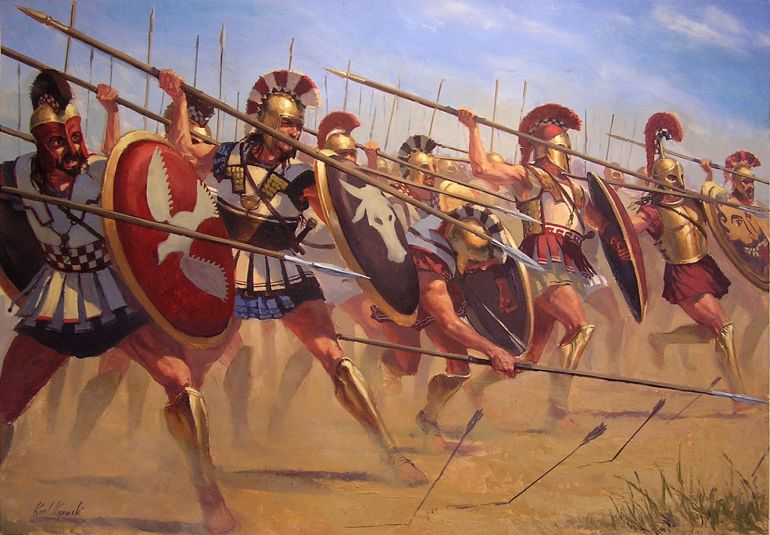
When we talk about Classical Greek hoplites, we mean the armored citizen-soldiers who dominated the Greek military world from the early 5th century BC to the late 4th century BC (before the rise of Alexander the Great). And as mentioned earlier, while popular depictions showcase superbly heavy and imposing ‘bronzed’ round shields being carried by the Greek hoplites, the aspis was not necessarily meant to be ‘excessive’ in its structure.
In fact, the ‘classic’ hoplite large shield was just a bit heavier than the reformed Roman scutum that weighed 12 lbs. Even its ‘bronzed’ part included just a thin bronze ring (less than half-millimeter in thickness) that covered the wooden shield on the outer face. As for the wood itself, lightweight varieties like poplar and willow were used in composite layers (much like modern-day plywood).
In essence, the aspis was rather tailored to mobility as opposed to heavy protective equipment. Simply put, the hoplite shield acted as a practical deterrent to spear and sword thrusts that must have been common in melee combat scenarios.
But it was not exactly the best solution for projectiles that had greater kinetic energy, like javelins and arrows. Pottery scenes conform to the latter mentioned shortcoming of aspis by depicting various pierced shields.
Similarly, in the case of body armor, the Classical hoplites steadily made their switch from the aforementioned heavy muscled cuirass (made of bronze) to the lighter and more flexible linothorax – which still offered decent protection. This does suggest a shift in tactical thinking wherein the hoplite was expected to have a more mobile role on the battlefield, especially during the Persian Wars and the Peloponnesian War (circa 431–404 BC).
The Hoplite Phalanx
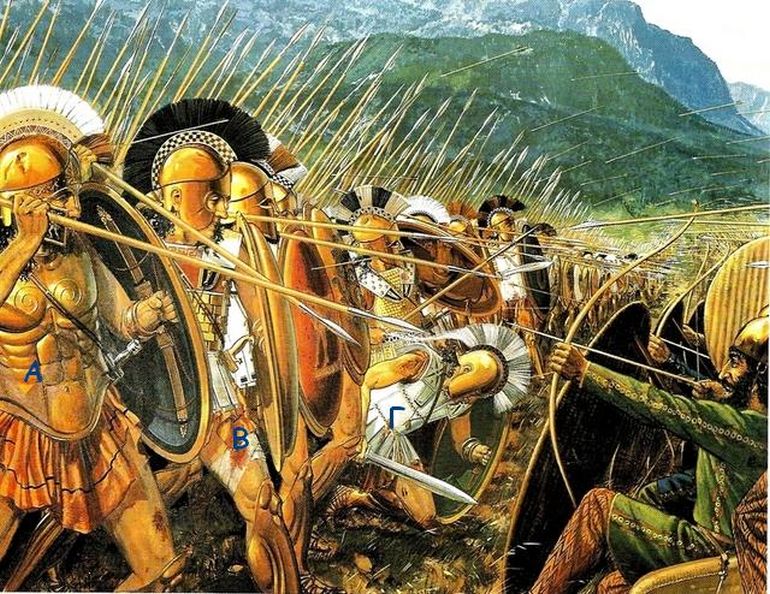
Gone were the days of the euphemistic ‘Heroic Age’ (or Bronze Age), when men fought in chaotic huddles and chosen warriors picked at one another. The Greek hoplites were part of an ‘institution’ that fought in a phalanx formation – where every member looked out for each other. Thus the aspis shield was considered the most crucial part of hoplite battle equipment.
For example, when the exiled Spartan king Demaratos was asked the question – why men are dishonored only when they lose their shields but not when they lose their cuirasses? The Spartan king made his case – ‘because the latter [other armors] they put on for their own protection, but the shield for the common good of the whole line.’
Interestingly, Xenophon also talked about the more tactical side of a hoplite phalanx, which was more than just a closely-packed mass of armored spearmen. In fact, many modern researchers have theorized if the situation allowed, the ancient hoplites were open to breaking the phalanx formation of the shield wall to engage their enemies. Furthermore, the Classical hoplite was different than his Archaic predecessor – as in he was more flexible in both his armor and tactical outlook.
To that end, Xenophon draws a comparison to the construction of a well-built house (in Memorabilia) – “just as stones, bricks, timber and tiles flung together anyhow are useless, whereas when the materials that neither rot nor decay, that is, the stones and tiles, are placed at the bottom and the top, and the bricks and timber are put together in the middle, as in building, the result is something of great value, a house, in fact.”
Similarly, in the case of a (flexible) phalanx of Classical Greek hoplites, the historian talks about how the best men should be placed both in the front and rear of the ranks. With this ‘modified’ formation, the men in the middle (with presumably lesser moral or physical prowess) would be inspired by the front-placed men while also being ‘physically’ driven forth by the rear-placed men.
Overarm Thrusts or Upward Thrusts?
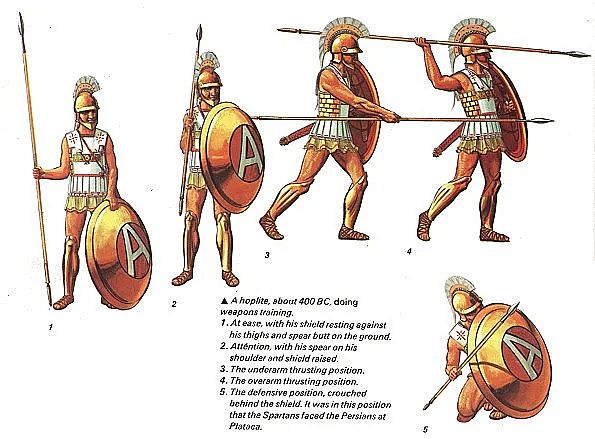
Talking of tactics, there is an ongoing debate in academic circles regarding how the hoplites used their main offensive weapon – the spear or dory. The primary argument relates to the position of the spear grip relative to the shoulder, i.e., underarm carry or overarm carry, with visual evidence (like pottery) mainly alluding to the latter.
Taking practicality into consideration, it is entirely possible that both of the grips were used. For example, when defending within the phalanx formation, an underarm carry absorbed more pressure from the opponent because the spear could be couched beneath the shoulder level – thus allowing for more stability.
However, at the same time, an upward thrust had less impact or momentum, simply because of its lesser leverage, reach, and defensive posture of the hoplite. Overarm thrusts (from overarm carry), on the other hand, had greater penetrating power while allowing for effective positioning with the large shield.
Taking these factors into consideration, it is plausible that the hoplites were expected to use the overarm thrust, especially in the front ranks. Taking the Battle of Marathon as an example, Herodotus mentioned how the Greek phalanx broke rank and then advanced (or charged) into the Persian lines, which would suggest that they used the overarm grip for more momentum in close combat.
Concurrently, the underarm grip may have been used by the rear ranks whose objective relied more on defense rather than offense. Some have even hypothesized how these hoplites at the rear may have held their shields at a particular angle so as to deflect the arrows or javelins thrown by the foe.
The Famed Helmet Crests were just for Show and Pomp
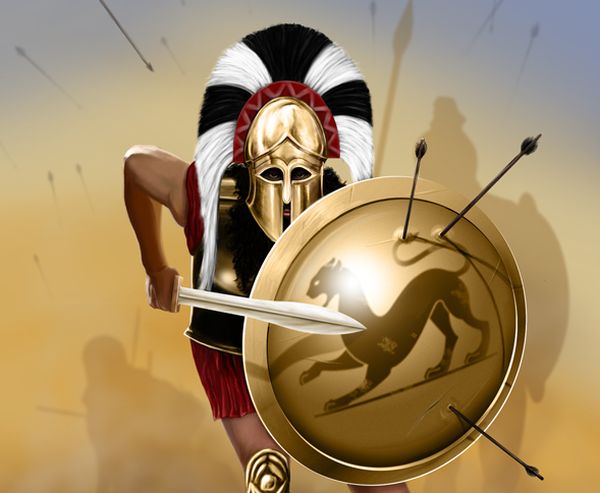
Horsehair crests upon helmets have long been the favorite of historical reenactment groups and (even it seems) in the actual ancient armies. Ubiquitously dyed in bright and gaudy colors, they unsurprisingly didn’t serve any practical purpose. However, such ‘decorations’ might have had some psychological value – with the flourishing crest giving a more imposing air to the wearer while also making him appear taller.
And by the latter Classical period, the type of crest was also related to the rank of the hoplite. For example, Lamachus, the Athenian general who took part in the Peloponnesian War embellished his helmet with three crests and two plumes (as mentioned by Nicholas Sekunda in the Greek Hoplite).
Interestingly, the famed Spartan crimson cloaks were also adopted primarily because of their visual predominance. Plutarch mentioned how the red-hued clothing might have psychologically afflicted the defeated enemy, while also hiding the Spartan’s blood wounds.
This explanation might have some justification since most Greek armies contemporary to even Xenophon’s time (the first half of the 4th century BC) adopted some variants of the crimson clothing, probably inspired by their Spartan counterparts. And lastly, there was (and still is) the association of vibrant colors with swagger – as demonstrated by flashy footsoldiers of an altogether different era of the 16th century AD.
Physical Infirmity was Possibly Overlooked in Case of Spartan Hoplites
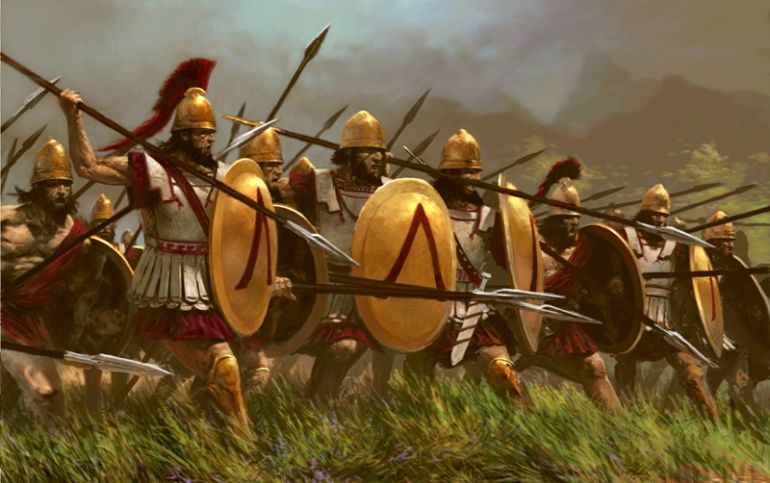
The movie 300 depicted how a physically deformed man named Ephialtes betrayed the Spartans because he was not allowed to serve in the Hoplite phalanx. Herodotus’ account, however, doesn’t take such a ‘fantastical’ route.
In fact, going by historical accounts, even men with physical infirmities were liable to serve in the Spartan army, with the greatest example pertaining to Agesilaos (or Agesilaus II), the limping warrior-king of Sparta who oversaw numerous forays into Asia Minor while also playing a successful part in the Corinthian War.
And while infant inspections possibly happened as portrayed in the aforementioned movie (at least in a few instances), the handicapped adult Spartan probably expected himself to be enrolled in their fighting army.
Plutarch gives us an account of a Spartan named Androkleidas who was crippled and ultimately turned down when he wanted to join the Hoplite ranks. His retort was – ‘I do not have to be able to run away, but rather to stand and fight the foe.’
Wine Before Battle
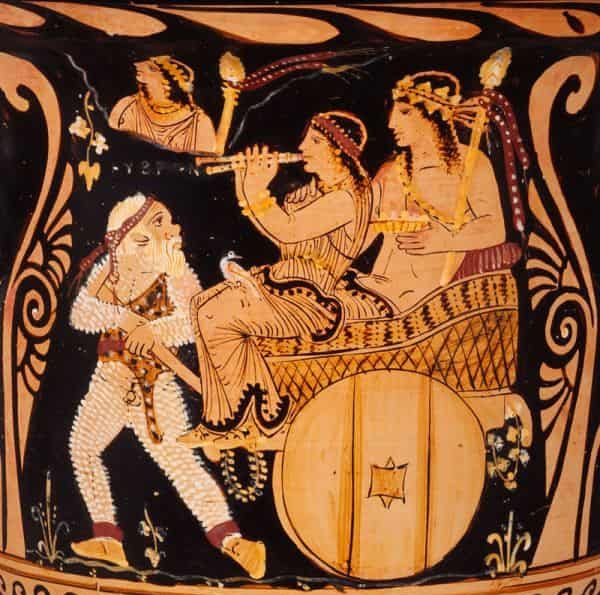
The ancient Greeks mostly took their meals during two particular times in a day, with ariston equating to what is known as ‘brunch’ nowadays and deipnon equating to dinner – thus allowing most battles to take place in the afternoon period.
During both these times, the wine was consumed in moderate amounts. However, as Nicholas Sekunda mentions, the Greek hoplites had the tendency to consume extra alcohol or wine just before a battle, so as to calm their nerves.
Even a few commanders partook in such ‘reveling’ before serious battlefield encounters. Xenophon mentions how Spartan king Kleombrotos I and his officers drank too much in their council before the disastrous Battle of Leuctra.
On the other hand, it should also be noted that ariston was the crucial time when many commanders also ‘soberly’ planned out their moves that involved the formation and maneuvers of their army.
Conclusion – Morale More Important Than Numbers
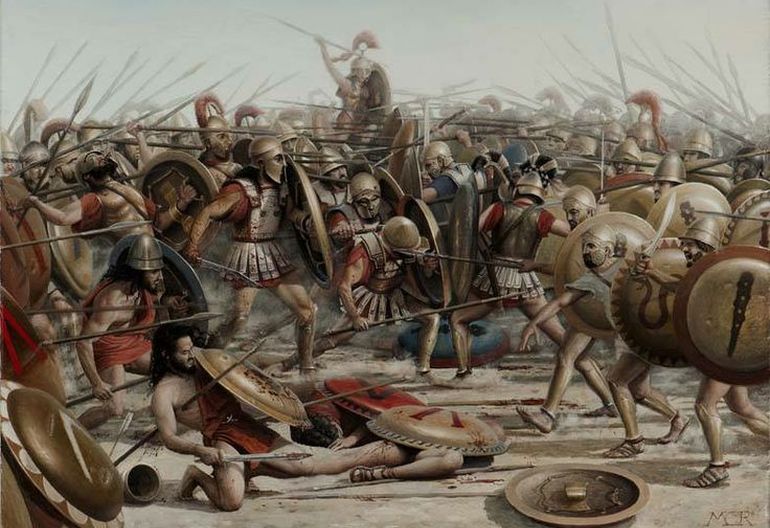
Another popular depiction of ancient warfare frequently involves the pushing and shoving of the Greek hoplites when they meet with the enemy. Now while such a scenario was probably the credible outcome of two tight phalanxes clashing with each other, in reality, many battles didn’t even come to the scope of ‘physical contact’.
In other words, a frenzied hoplite charge (as opposed to a purposeful advance) was often not successful because the citizen-soldiers tended to break their ranks (and disperse) even before starting a bold maneuver. As a result, the army that held its ground often emerged victorious – thus exemplifying how morale was far more important than sheer strength in numbers (which alludes to why the Spartans were considered lethal on the battlefield).
To this end, one must understand that typical hoplites were not exactly professional soldiers. In fact, it can be argued that a significant percentage of these citizen soldiers lacked sufficient military training (with the exception of Spartans) – because ultimately the conscripted soldier was tied to his farming land.
Intriguingly, this once again brings us to Xenophon’s ‘house analogy’, where he says the best men were to be placed in the front and rear of a phalanx. And from a practical perspective, while the front-placed men didn’t have any space to run away from the battlefield, it was the rear-placed men who tended to break away from the subsequent charge, thus ultimately resulting in their dispersal.
One of the solutions for this morale-based predicament was to make the phalanx deeper with more men, so as to psychologically reinforce (rather than physically support) the ones in the rear. At the same time, the phalanx could have been made more flexible (or less tight) for better maneuverability on the battlefield.
Another deep-rooted tradition involved the singing of encouraging hymns (paeans) dedicated to gods of war just before the hoplites were to begin their advance. So, as with many Greek customs, there might have been a practical side underneath this seemingly religious veneer.
Thucydides himself mentioned how the songs and their tunes kept the marching line in order, which encompassed a major battlefield tactic – since Greek warfare (and victory) generally involved closing in with the enemy with a solid, unbroken line.
Note* – The article was updated on 2nd August 2022.
Sources: MilitaryFactory / Livius / BBC / Koryvantes / LARP
Book References: Sport and Recreation in Ancient Greece (by Waldo E. Sweet) / The Greek Hoplite 480-323 BC (by Nicholas Sekunda) / The Cambridge History of Greek and Roman Warfare
Other References: HeavenGames
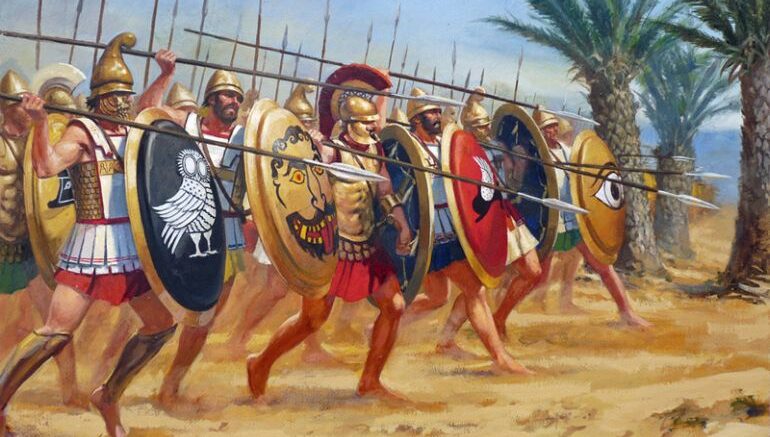


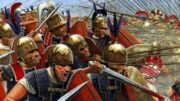

Be the first to comment on "Hoplite: The Remarkable Citizen-Soldier of Ancient Greece"